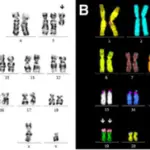Pseudohermaphroditism is a condition in which an individual has a matching chromosomal and gonadal tissue (ovary or testis) sex, but mismatching external genitalia.
What is the Pathology of Pseudohermaphroditism?
The pathology of pseudohermaphroditism is:
-Etiology: The causes of pseudohermaphroditism are inability to synthesize estrogens from androgens, hormonal resistance due to androgen receptor dysfunction, or 5α-reductase deficiency.
-Genes involved: Y chromosome. SRY gene.
-Pathogenesis: Persistent müllerian ducts.
How does Pseudohermaphroditism Present?
Patients with pseudohermaphroditism typically present early in life. In some cases, external sex organs associated with pseudohermaphroditism appear intermediate between a typical clitoris and penis. Thus, pseudohermaphroditism is sometimes not identified until puberty or adulthood. The symptoms, features, and clinical findings associated with pseudohermaphroditism include external genitalia of the opposite sex.
How is Pseudohermaphroditism Diagnosed?
Pseudohermaphroditism is diagnosed by initial investigations include chromosome analysis and an ultrasound scan to check the internal reproductive organs. Patients who present later in life have higher differentiation of genitalia. Diagnosis requires careful anatomical assessment via imaging modalities and/or laparoscopy. Biochemical endocrine investigation, cytogenetic and molecular genetic tests are required.
How is Pseudohermaphroditism Treated?
Hormonal and other medical interventions performed to modify atypical or ambiguous genitalia and other sex characteristics.
What is the Prognosis of Pseudohermaphroditism?
The prognosis of pseudohermaphroditism is good. Patients usually have normal life expectancy.



